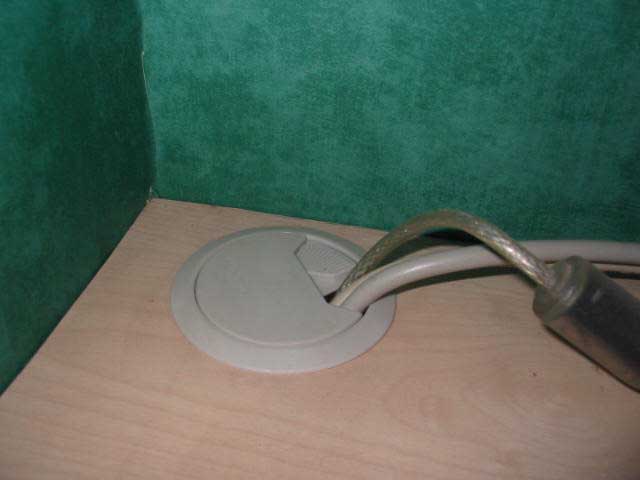Difference between revisions of "Cable organising"
(4 more setions) |
|||
| Line 14: | Line 14: | ||
tbc | tbc | ||
| + | |||
| + | |||
| + | ==Desk Gap== | ||
| + | A 1/2" - 3/4" gap between the rear of the desk and the wall also works as a full width cable port. | ||
| + | |||
| + | |||
| + | ==Using the PC's Power Supply== | ||
| + | Many computer accessories powered from wallwarts can more tidily be powered from the computer's built in power supply. PC supplies deliver 12v, 5v and 3.3v. To connect an accessory to the computer requires a molex connector, and it means opening the cover to plug it in. | ||
| + | * 5v runs 5v and 6v appliances, such as small speakers | ||
| + | * 12v runs 12v appliances and larger speakers (12-16v) which are not voltage critical | ||
| + | * 12v can also supply voltages between 5v and 12v by using series dropping diodes or a voltage regulator. | ||
| + | * 3.3v runs portable devices that use 2x 1.5v batteries, eg music players. | ||
| + | |||
| + | There are limits to how much power you can draw from the PC's supply, but there is little likelihood of reaching those limits with a modern PC. On the other hand a 486 with a 120w PSU would reach these limits quickly, but can happily run small speakers on 5v, if not much else. | ||
| + | |||
| + | |||
| + | ==Shorter Leads== | ||
| + | Trimming flexes to the length needed can reduce the amount of flex on show significantly. but can be inconvenient later. This approach is recommended with plug in flexes, which are easily swapped if necessary. | ||
| + | |||
| + | |||
| + | ==2 Way Leads== | ||
| + | Some leads are available in 2 way versions. These have 2 leads and one mains plug. Often the lead is Y shaped. These reduce plug, socket, flex and sometimes extension lead use. | ||
| + | |||
| + | 2 way leads are only recommended for appliances that stay in the same place, use on mobile items could result in unplugged connectors lying on the floor. | ||
| + | |||
| + | 2 way leads may be safely made from existing leads by putting 2 leads into one mains plug, provided that both flexes are of the same size, both fit the plug (some plugs have enough space, some don't), and both are gripped securely by the cord grip. | ||
| + | |||
| + | |||
| + | [[Category:Electrical]] | ||
Revision as of 08:03, 4 January 2007
Desk cable tidies
Anyone building a bespoke office desk will be faced with the issue of how to organise the plethora of cable and flexes associated with a modern office, notably for computing equipment. Any commercially obtained office desk is likely to have a hole in one corner of the worktop to allow the passage of cables from a keyboard / mouse / telephone / desklamp etc etc, and this will be lined with a plastic 'grommet' or desk cable tidy. These typically have an inset adjustable cap, to accomodate different sizes and bundles of cables, and are deliberately large enough to accept at least a standard UK 13A plug:

These cable tidies are readily obtainable from a number of sources, eg:
Another method of keeping cable tidy
tbc
Desk Gap
A 1/2" - 3/4" gap between the rear of the desk and the wall also works as a full width cable port.
Using the PC's Power Supply
Many computer accessories powered from wallwarts can more tidily be powered from the computer's built in power supply. PC supplies deliver 12v, 5v and 3.3v. To connect an accessory to the computer requires a molex connector, and it means opening the cover to plug it in.
- 5v runs 5v and 6v appliances, such as small speakers
- 12v runs 12v appliances and larger speakers (12-16v) which are not voltage critical
- 12v can also supply voltages between 5v and 12v by using series dropping diodes or a voltage regulator.
- 3.3v runs portable devices that use 2x 1.5v batteries, eg music players.
There are limits to how much power you can draw from the PC's supply, but there is little likelihood of reaching those limits with a modern PC. On the other hand a 486 with a 120w PSU would reach these limits quickly, but can happily run small speakers on 5v, if not much else.
Shorter Leads
Trimming flexes to the length needed can reduce the amount of flex on show significantly. but can be inconvenient later. This approach is recommended with plug in flexes, which are easily swapped if necessary.
2 Way Leads
Some leads are available in 2 way versions. These have 2 leads and one mains plug. Often the lead is Y shaped. These reduce plug, socket, flex and sometimes extension lead use.
2 way leads are only recommended for appliances that stay in the same place, use on mobile items could result in unplugged connectors lying on the floor.
2 way leads may be safely made from existing leads by putting 2 leads into one mains plug, provided that both flexes are of the same size, both fit the plug (some plugs have enough space, some don't), and both are gripped securely by the cord grip.